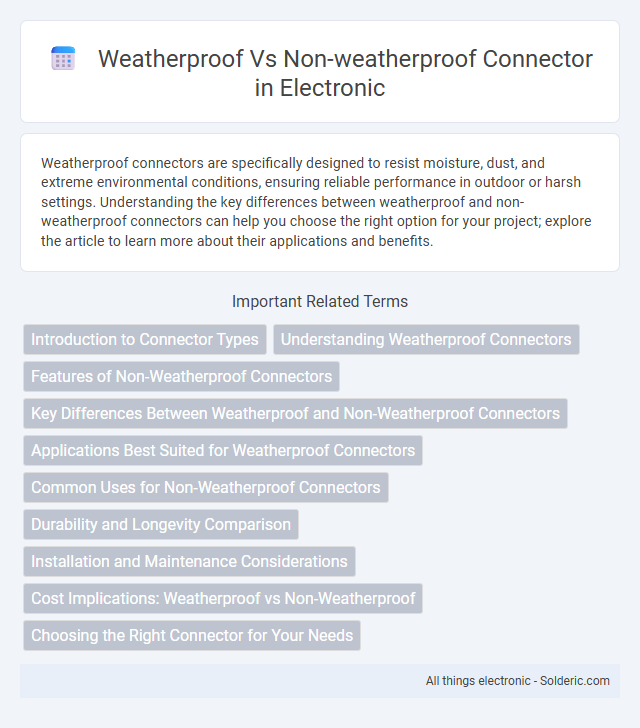Weatherproof connectors are specifically designed to resist moisture, dust, and extreme environmental conditions, ensuring reliable performance in outdoor or harsh settings. Understanding the key differences between weatherproof and non-weatherproof connectors can help you choose the right option for your project; explore the article to learn more about their applications and benefits.
Comparison Table
| Feature | Weatherproof Connector | Non-Weatherproof Connector |
|---|---|---|
| Protection | Sealed against water, dust, and moisture | No sealing, vulnerable to environmental elements |
| Durability | High; designed for outdoor and harsh conditions | Lower; suitable for indoor or controlled environments |
| Applications | Outdoor equipment, automotive, industrial use | Indoor electronics, appliances, temporary setups |
| Cost | Generally higher due to protective features | Usually lower cost |
| Installation | Requires careful sealing and sometimes specialized tools | Simpler installation without special tools |
| Lifespan | Longer lifespan in harsh environments | Shorter lifespan if exposed outdoors |
Introduction to Connector Types
Weatherproof connectors are designed to withstand exposure to moisture, dust, and extreme environmental conditions, making them ideal for outdoor and industrial applications. Non-weatherproof connectors lack protective sealing, making them suitable for indoor or controlled environments where exposure to harsh elements is minimal. Choosing the right connector type ensures your electrical connections remain reliable and safe under specific environmental demands.
Understanding Weatherproof Connectors
Weatherproof connectors are designed with seals and durable materials to prevent water, dust, and other environmental elements from compromising electrical connections, making them ideal for outdoor and harsh environment applications. These connectors often feature rubber gaskets, silicone seals, and corrosion-resistant coatings to maintain reliable performance in extreme weather conditions. In contrast, non-weatherproof connectors lack these protective features and are better suited for indoor or controlled environments where exposure to moisture and contaminants is minimal.
Features of Non-Weatherproof Connectors
Non-weatherproof connectors typically feature simpler designs without sealing mechanisms, making them suitable for indoor or controlled environments. These connectors often lack gaskets or protective coatings, which means they are more susceptible to moisture, dust, and corrosion. Your choice of non-weatherproof connectors should consider environmental exposure to ensure optimal performance and avoid premature failure.
Key Differences Between Weatherproof and Non-Weatherproof Connectors
Weatherproof connectors feature sealed designs with rubber gaskets and corrosion-resistant materials to prevent water, dust, and moisture intrusion, ensuring reliable performance in harsh outdoor environments. Non-weatherproof connectors lack these protective measures, making them suitable only for indoor or controlled settings where exposure to elements is minimal. The key differences lie in their construction and intended use, with weatherproof connectors offering enhanced durability and longevity under extreme weather conditions.
Applications Best Suited for Weatherproof Connectors
Weatherproof connectors are best suited for outdoor and harsh environment applications where exposure to moisture, dust, and extreme temperatures is common, such as in automotive, marine, and industrial equipment. These connectors provide reliable sealing with IP67 or higher ratings, ensuring your electrical systems maintain integrity in wet or rugged conditions. Non-weatherproof connectors, on the other hand, are ideal for controlled indoor environments where exposure to the elements is minimal.
Common Uses for Non-Weatherproof Connectors
Non-weatherproof connectors are commonly used in indoor electronic devices, office equipment, and consumer electronics where exposure to moisture, dust, or extreme temperatures is minimal. These connectors are ideal for applications such as computer peripherals, audio-video equipment, and internal machinery connections that require reliable electrical contact without the need for environmental sealing. Their cost-effectiveness and ease of installation make them suitable for environments with controlled climate and low risk of contamination.
Durability and Longevity Comparison
Weatherproof connectors feature robust sealing materials such as rubber gaskets and corrosion-resistant coatings that enhance durability by preventing moisture, dust, and temperature extremes from compromising internal components. Non-weatherproof connectors lack these protective elements, making them vulnerable to environmental damage, which significantly reduces their lifespan in outdoor or harsh conditions. As a result, weatherproof connectors offer superior longevity and reliable performance in settings exposed to weather, whereas non-weatherproof connectors are better suited for controlled indoor environments.
Installation and Maintenance Considerations
Weatherproof connectors require careful sealing with gaskets or rubber rings during installation to prevent moisture ingress, ensuring long-term durability in harsh environments. Non-weatherproof connectors are easier to install but need to be placed in protected or indoor locations, as they lack protection against water and dust, increasing the risk of corrosion and failure. Maintenance of weatherproof connectors involves regular inspection of seals and cleaning to maintain waterproof integrity, while non-weatherproof connectors demand more frequent checks for contamination and damage due to their exposure vulnerabilities.
Cost Implications: Weatherproof vs Non-Weatherproof
Weatherproof connectors typically incur higher upfront costs due to specialized sealing materials and robust construction designed to withstand moisture and harsh environments. Non-weatherproof connectors are more budget-friendly initially but may lead to increased maintenance or replacement expenses if exposed to adverse conditions. Choosing the right type affects your overall investment by balancing initial cost against long-term durability and reliability.
Choosing the Right Connector for Your Needs
Selecting the right connector involves understanding the key differences between weatherproof and non-weatherproof options; weatherproof connectors are designed with seals and durable materials to protect against moisture, dust, and temperature variations, making them ideal for outdoor or harsh environments. Non-weatherproof connectors, while generally more cost-effective, are suited for indoor applications where exposure to the elements is minimal. Your choice should align with the environmental conditions and reliability requirements of your specific project to ensure optimal performance and longevity.
Weatherproof vs Non-weatherproof connector Infographic

 solderic.com
solderic.com